Analysis of Kellogg's Organizational Structure and Company Culture
VerifiedAdded on 2021/02/20
|9
|2518
|75
Report
AI Summary
This report examines the organizational structure and culture of Kellogg's, a multinational food processing company. It explores key concepts such as organizational culture, including task culture, and its importance in maintaining brand image and employee relations. The report delves into Kellogg's history, highlighting its evolution and global expansion, and analyzes its adoption of a divisional organizational structure. It further discusses formal and informal cultures, Hofstede's cultural dimensions, and the role of motivation and engagement, including Maslow's hierarchy of needs, in enhancing employee performance. The report concludes with recommendations for continuous improvement, emphasizing training, motivation, and positive reinforcement, and underscores the significance of organizational culture and structure in achieving business objectives, especially in a global context.
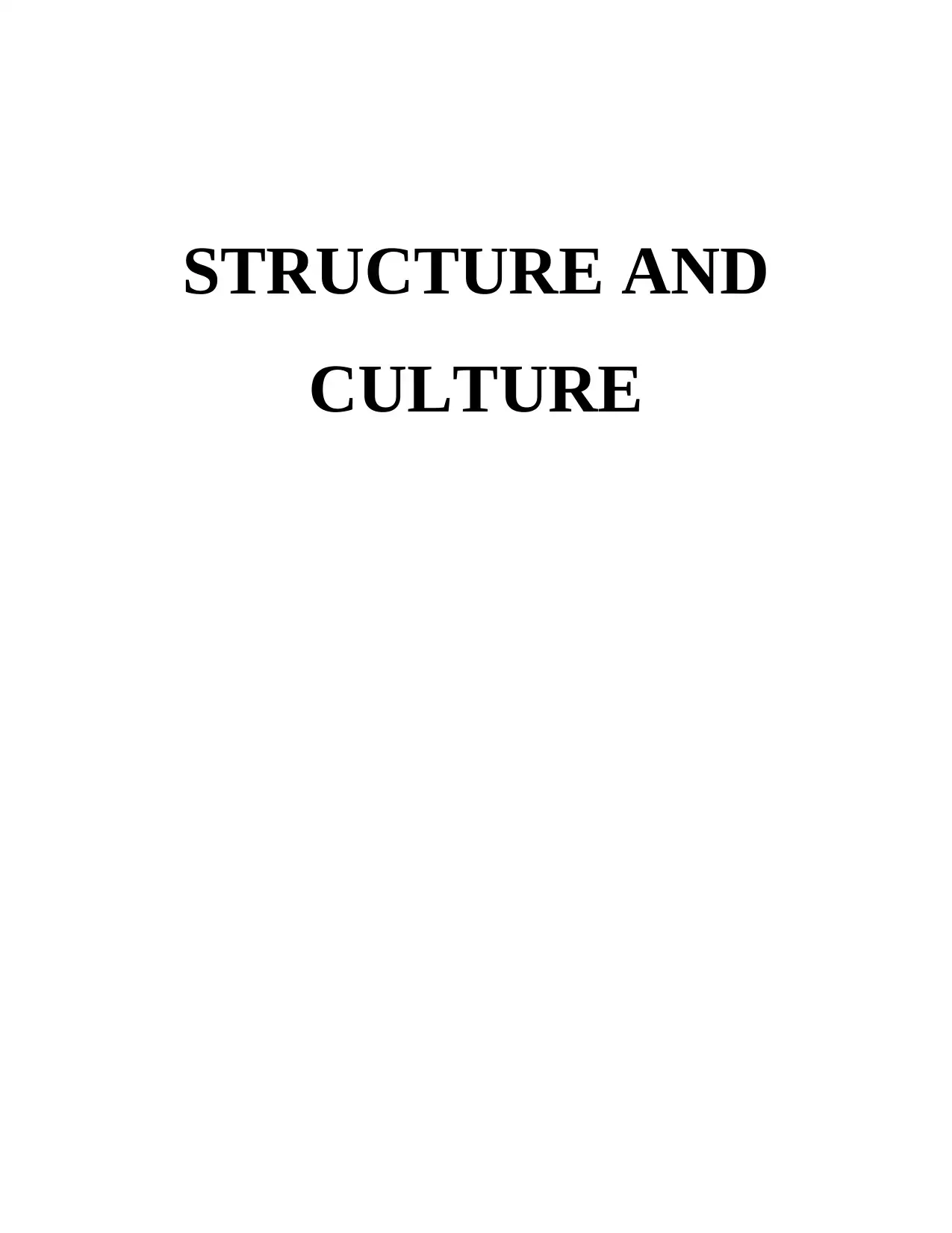
STRUCTURE AND
CULTURE
CULTURE
Paraphrase This Document
Need a fresh take? Get an instant paraphrase of this document with our AI Paraphraser
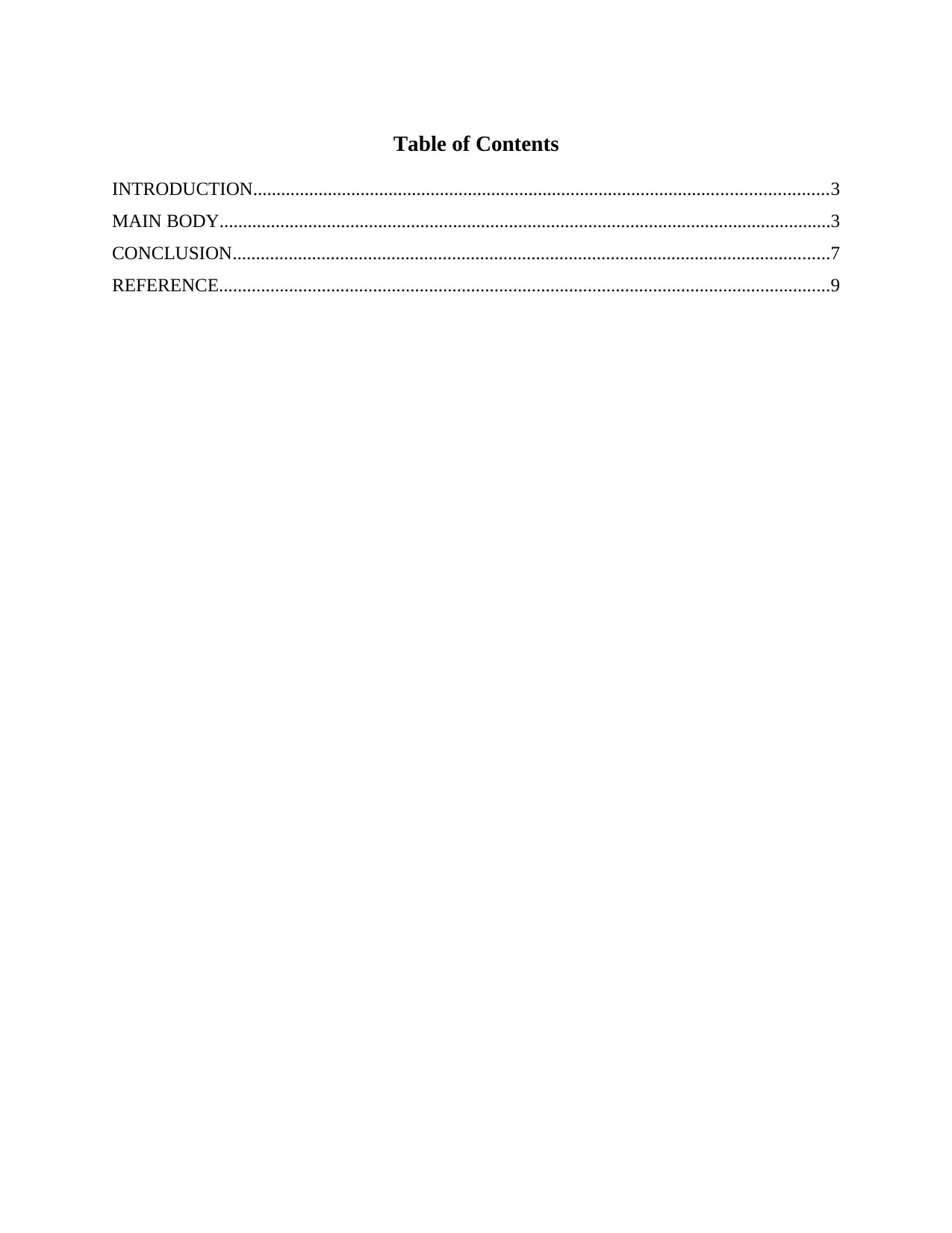
Table of Contents
INTRODUCTION...........................................................................................................................3
MAIN BODY...................................................................................................................................3
CONCLUSION................................................................................................................................7
REFERENCE...................................................................................................................................9
INTRODUCTION...........................................................................................................................3
MAIN BODY...................................................................................................................................3
CONCLUSION................................................................................................................................7
REFERENCE...................................................................................................................................9
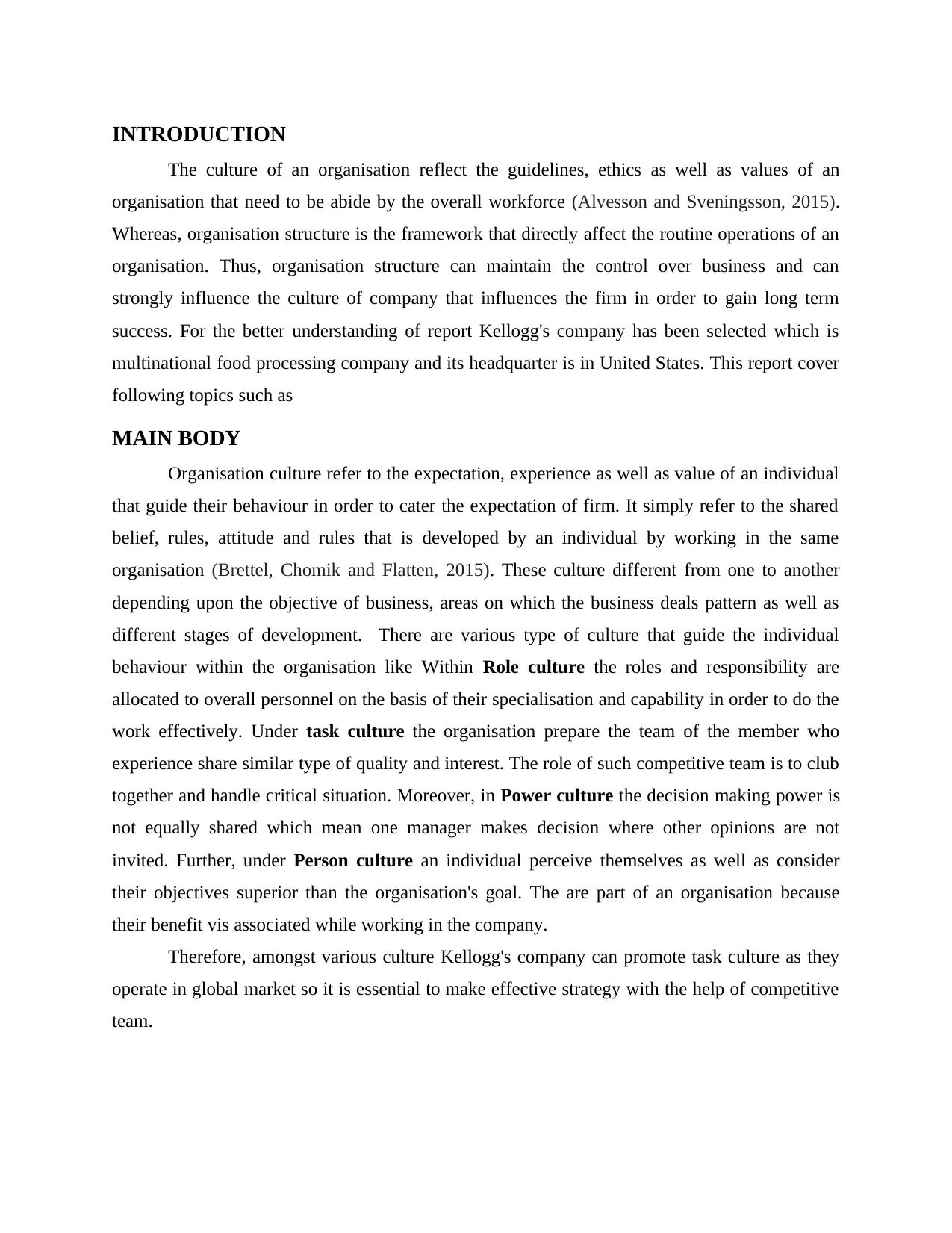
INTRODUCTION
The culture of an organisation reflect the guidelines, ethics as well as values of an
organisation that need to be abide by the overall workforce (Alvesson and Sveningsson, 2015).
Whereas, organisation structure is the framework that directly affect the routine operations of an
organisation. Thus, organisation structure can maintain the control over business and can
strongly influence the culture of company that influences the firm in order to gain long term
success. For the better understanding of report Kellogg's company has been selected which is
multinational food processing company and its headquarter is in United States. This report cover
following topics such as
MAIN BODY
Organisation culture refer to the expectation, experience as well as value of an individual
that guide their behaviour in order to cater the expectation of firm. It simply refer to the shared
belief, rules, attitude and rules that is developed by an individual by working in the same
organisation (Brettel, Chomik and Flatten, 2015). These culture different from one to another
depending upon the objective of business, areas on which the business deals pattern as well as
different stages of development. There are various type of culture that guide the individual
behaviour within the organisation like Within Role culture the roles and responsibility are
allocated to overall personnel on the basis of their specialisation and capability in order to do the
work effectively. Under task culture the organisation prepare the team of the member who
experience share similar type of quality and interest. The role of such competitive team is to club
together and handle critical situation. Moreover, in Power culture the decision making power is
not equally shared which mean one manager makes decision where other opinions are not
invited. Further, under Person culture an individual perceive themselves as well as consider
their objectives superior than the organisation's goal. The are part of an organisation because
their benefit vis associated while working in the company.
Therefore, amongst various culture Kellogg's company can promote task culture as they
operate in global market so it is essential to make effective strategy with the help of competitive
team.
The culture of an organisation reflect the guidelines, ethics as well as values of an
organisation that need to be abide by the overall workforce (Alvesson and Sveningsson, 2015).
Whereas, organisation structure is the framework that directly affect the routine operations of an
organisation. Thus, organisation structure can maintain the control over business and can
strongly influence the culture of company that influences the firm in order to gain long term
success. For the better understanding of report Kellogg's company has been selected which is
multinational food processing company and its headquarter is in United States. This report cover
following topics such as
MAIN BODY
Organisation culture refer to the expectation, experience as well as value of an individual
that guide their behaviour in order to cater the expectation of firm. It simply refer to the shared
belief, rules, attitude and rules that is developed by an individual by working in the same
organisation (Brettel, Chomik and Flatten, 2015). These culture different from one to another
depending upon the objective of business, areas on which the business deals pattern as well as
different stages of development. There are various type of culture that guide the individual
behaviour within the organisation like Within Role culture the roles and responsibility are
allocated to overall personnel on the basis of their specialisation and capability in order to do the
work effectively. Under task culture the organisation prepare the team of the member who
experience share similar type of quality and interest. The role of such competitive team is to club
together and handle critical situation. Moreover, in Power culture the decision making power is
not equally shared which mean one manager makes decision where other opinions are not
invited. Further, under Person culture an individual perceive themselves as well as consider
their objectives superior than the organisation's goal. The are part of an organisation because
their benefit vis associated while working in the company.
Therefore, amongst various culture Kellogg's company can promote task culture as they
operate in global market so it is essential to make effective strategy with the help of competitive
team.
⊘ This is a preview!⊘
Do you want full access?
Subscribe today to unlock all pages.

Trusted by 1+ million students worldwide
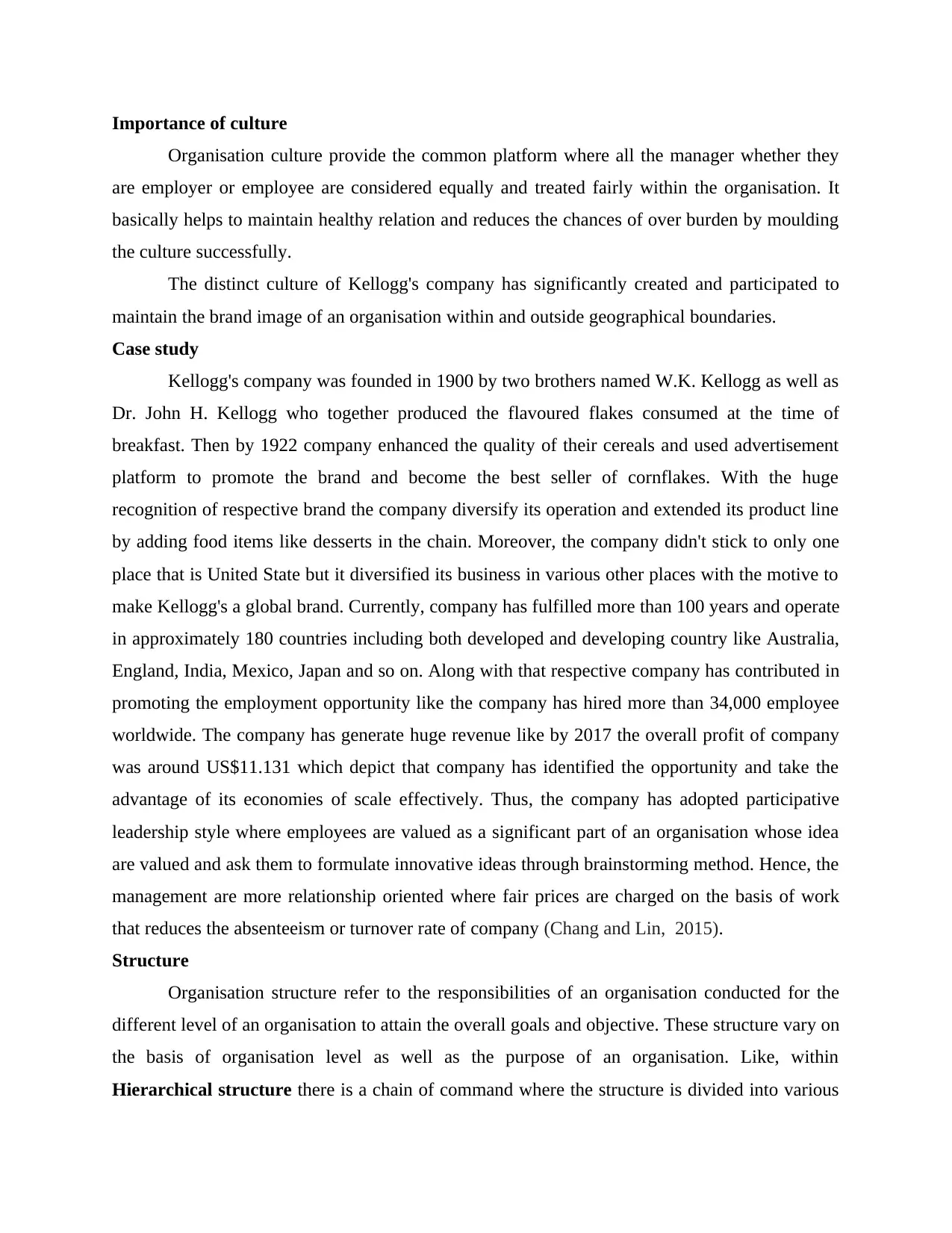
Importance of culture
Organisation culture provide the common platform where all the manager whether they
are employer or employee are considered equally and treated fairly within the organisation. It
basically helps to maintain healthy relation and reduces the chances of over burden by moulding
the culture successfully.
The distinct culture of Kellogg's company has significantly created and participated to
maintain the brand image of an organisation within and outside geographical boundaries.
Case study
Kellogg's company was founded in 1900 by two brothers named W.K. Kellogg as well as
Dr. John H. Kellogg who together produced the flavoured flakes consumed at the time of
breakfast. Then by 1922 company enhanced the quality of their cereals and used advertisement
platform to promote the brand and become the best seller of cornflakes. With the huge
recognition of respective brand the company diversify its operation and extended its product line
by adding food items like desserts in the chain. Moreover, the company didn't stick to only one
place that is United State but it diversified its business in various other places with the motive to
make Kellogg's a global brand. Currently, company has fulfilled more than 100 years and operate
in approximately 180 countries including both developed and developing country like Australia,
England, India, Mexico, Japan and so on. Along with that respective company has contributed in
promoting the employment opportunity like the company has hired more than 34,000 employee
worldwide. The company has generate huge revenue like by 2017 the overall profit of company
was around US$11.131 which depict that company has identified the opportunity and take the
advantage of its economies of scale effectively. Thus, the company has adopted participative
leadership style where employees are valued as a significant part of an organisation whose idea
are valued and ask them to formulate innovative ideas through brainstorming method. Hence, the
management are more relationship oriented where fair prices are charged on the basis of work
that reduces the absenteeism or turnover rate of company (Chang and Lin, 2015).
Structure
Organisation structure refer to the responsibilities of an organisation conducted for the
different level of an organisation to attain the overall goals and objective. These structure vary on
the basis of organisation level as well as the purpose of an organisation. Like, within
Hierarchical structure there is a chain of command where the structure is divided into various
Organisation culture provide the common platform where all the manager whether they
are employer or employee are considered equally and treated fairly within the organisation. It
basically helps to maintain healthy relation and reduces the chances of over burden by moulding
the culture successfully.
The distinct culture of Kellogg's company has significantly created and participated to
maintain the brand image of an organisation within and outside geographical boundaries.
Case study
Kellogg's company was founded in 1900 by two brothers named W.K. Kellogg as well as
Dr. John H. Kellogg who together produced the flavoured flakes consumed at the time of
breakfast. Then by 1922 company enhanced the quality of their cereals and used advertisement
platform to promote the brand and become the best seller of cornflakes. With the huge
recognition of respective brand the company diversify its operation and extended its product line
by adding food items like desserts in the chain. Moreover, the company didn't stick to only one
place that is United State but it diversified its business in various other places with the motive to
make Kellogg's a global brand. Currently, company has fulfilled more than 100 years and operate
in approximately 180 countries including both developed and developing country like Australia,
England, India, Mexico, Japan and so on. Along with that respective company has contributed in
promoting the employment opportunity like the company has hired more than 34,000 employee
worldwide. The company has generate huge revenue like by 2017 the overall profit of company
was around US$11.131 which depict that company has identified the opportunity and take the
advantage of its economies of scale effectively. Thus, the company has adopted participative
leadership style where employees are valued as a significant part of an organisation whose idea
are valued and ask them to formulate innovative ideas through brainstorming method. Hence, the
management are more relationship oriented where fair prices are charged on the basis of work
that reduces the absenteeism or turnover rate of company (Chang and Lin, 2015).
Structure
Organisation structure refer to the responsibilities of an organisation conducted for the
different level of an organisation to attain the overall goals and objective. These structure vary on
the basis of organisation level as well as the purpose of an organisation. Like, within
Hierarchical structure there is a chain of command where the structure is divided into various
Paraphrase This Document
Need a fresh take? Get an instant paraphrase of this document with our AI Paraphraser
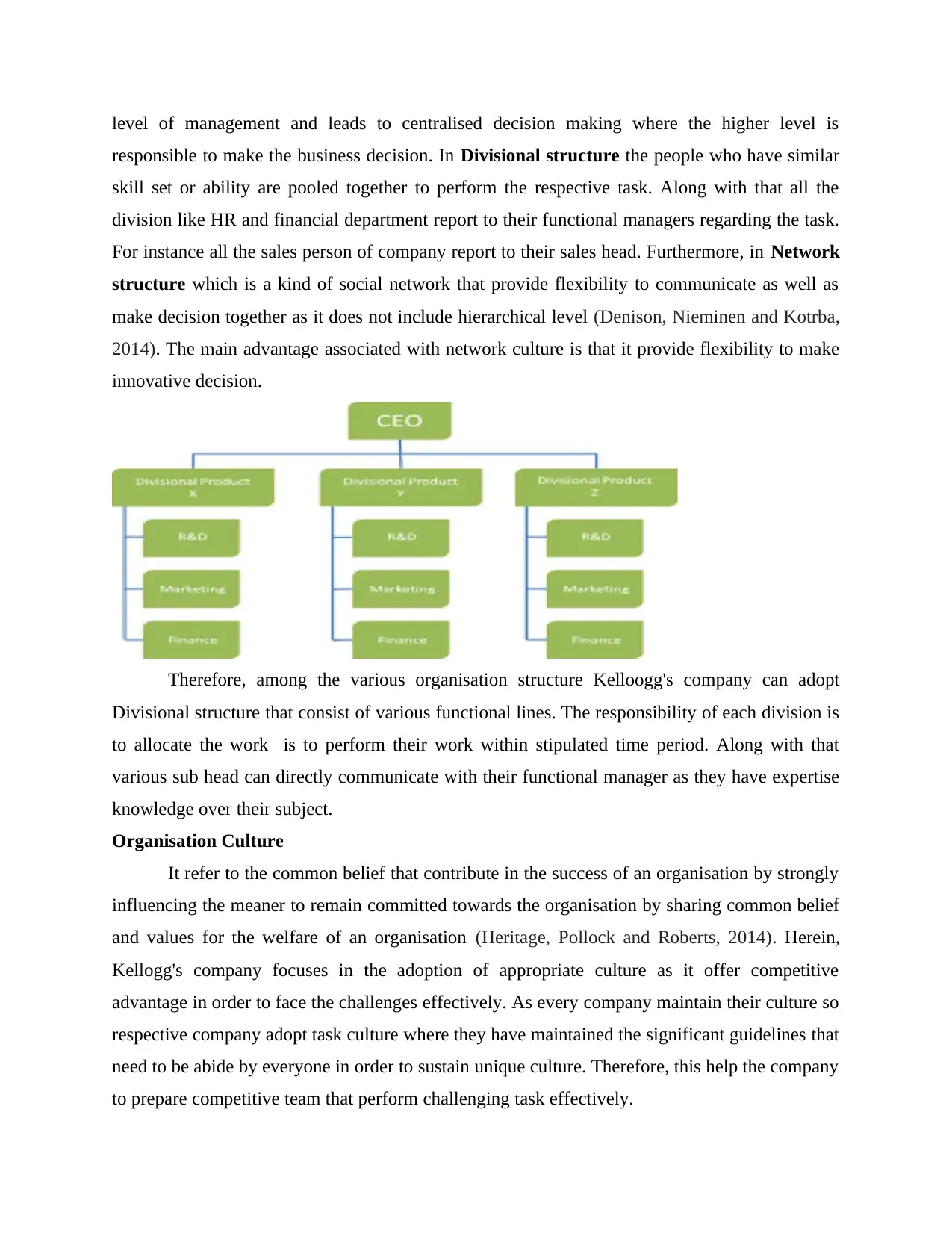
level of management and leads to centralised decision making where the higher level is
responsible to make the business decision. In Divisional structure the people who have similar
skill set or ability are pooled together to perform the respective task. Along with that all the
division like HR and financial department report to their functional managers regarding the task.
For instance all the sales person of company report to their sales head. Furthermore, in Network
structure which is a kind of social network that provide flexibility to communicate as well as
make decision together as it does not include hierarchical level (Denison, Nieminen and Kotrba,
2014). The main advantage associated with network culture is that it provide flexibility to make
innovative decision.
Therefore, among the various organisation structure Kelloogg's company can adopt
Divisional structure that consist of various functional lines. The responsibility of each division is
to allocate the work is to perform their work within stipulated time period. Along with that
various sub head can directly communicate with their functional manager as they have expertise
knowledge over their subject.
Organisation Culture
It refer to the common belief that contribute in the success of an organisation by strongly
influencing the meaner to remain committed towards the organisation by sharing common belief
and values for the welfare of an organisation (Heritage, Pollock and Roberts, 2014). Herein,
Kellogg's company focuses in the adoption of appropriate culture as it offer competitive
advantage in order to face the challenges effectively. As every company maintain their culture so
respective company adopt task culture where they have maintained the significant guidelines that
need to be abide by everyone in order to sustain unique culture. Therefore, this help the company
to prepare competitive team that perform challenging task effectively.
responsible to make the business decision. In Divisional structure the people who have similar
skill set or ability are pooled together to perform the respective task. Along with that all the
division like HR and financial department report to their functional managers regarding the task.
For instance all the sales person of company report to their sales head. Furthermore, in Network
structure which is a kind of social network that provide flexibility to communicate as well as
make decision together as it does not include hierarchical level (Denison, Nieminen and Kotrba,
2014). The main advantage associated with network culture is that it provide flexibility to make
innovative decision.
Therefore, among the various organisation structure Kelloogg's company can adopt
Divisional structure that consist of various functional lines. The responsibility of each division is
to allocate the work is to perform their work within stipulated time period. Along with that
various sub head can directly communicate with their functional manager as they have expertise
knowledge over their subject.
Organisation Culture
It refer to the common belief that contribute in the success of an organisation by strongly
influencing the meaner to remain committed towards the organisation by sharing common belief
and values for the welfare of an organisation (Heritage, Pollock and Roberts, 2014). Herein,
Kellogg's company focuses in the adoption of appropriate culture as it offer competitive
advantage in order to face the challenges effectively. As every company maintain their culture so
respective company adopt task culture where they have maintained the significant guidelines that
need to be abide by everyone in order to sustain unique culture. Therefore, this help the company
to prepare competitive team that perform challenging task effectively.
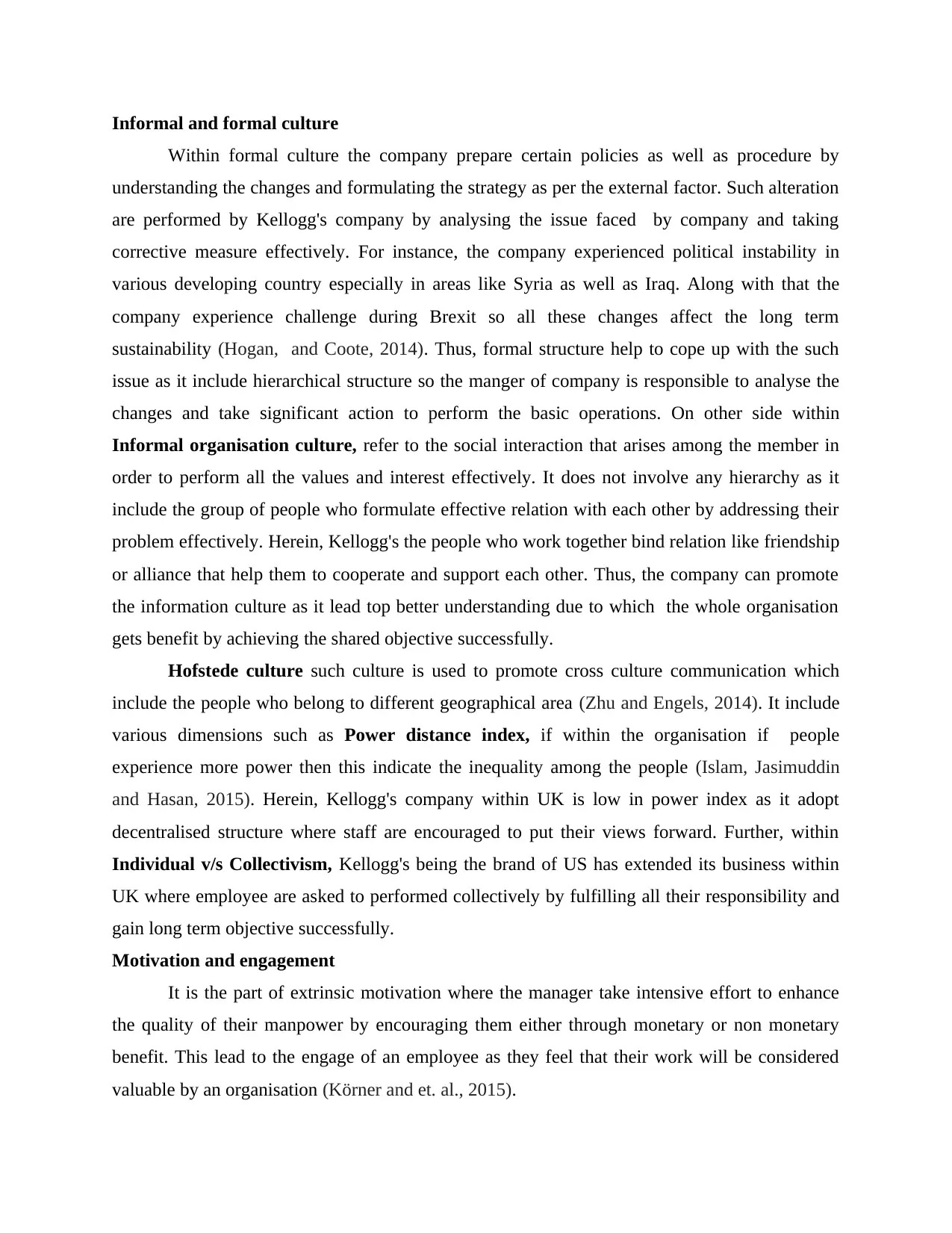
Informal and formal culture
Within formal culture the company prepare certain policies as well as procedure by
understanding the changes and formulating the strategy as per the external factor. Such alteration
are performed by Kellogg's company by analysing the issue faced by company and taking
corrective measure effectively. For instance, the company experienced political instability in
various developing country especially in areas like Syria as well as Iraq. Along with that the
company experience challenge during Brexit so all these changes affect the long term
sustainability (Hogan, and Coote, 2014). Thus, formal structure help to cope up with the such
issue as it include hierarchical structure so the manger of company is responsible to analyse the
changes and take significant action to perform the basic operations. On other side within
Informal organisation culture, refer to the social interaction that arises among the member in
order to perform all the values and interest effectively. It does not involve any hierarchy as it
include the group of people who formulate effective relation with each other by addressing their
problem effectively. Herein, Kellogg's the people who work together bind relation like friendship
or alliance that help them to cooperate and support each other. Thus, the company can promote
the information culture as it lead top better understanding due to which the whole organisation
gets benefit by achieving the shared objective successfully.
Hofstede culture such culture is used to promote cross culture communication which
include the people who belong to different geographical area (Zhu and Engels, 2014). It include
various dimensions such as Power distance index, if within the organisation if people
experience more power then this indicate the inequality among the people (Islam, Jasimuddin
and Hasan, 2015). Herein, Kellogg's company within UK is low in power index as it adopt
decentralised structure where staff are encouraged to put their views forward. Further, within
Individual v/s Collectivism, Kellogg's being the brand of US has extended its business within
UK where employee are asked to performed collectively by fulfilling all their responsibility and
gain long term objective successfully.
Motivation and engagement
It is the part of extrinsic motivation where the manager take intensive effort to enhance
the quality of their manpower by encouraging them either through monetary or non monetary
benefit. This lead to the engage of an employee as they feel that their work will be considered
valuable by an organisation (Körner and et. al., 2015).
Within formal culture the company prepare certain policies as well as procedure by
understanding the changes and formulating the strategy as per the external factor. Such alteration
are performed by Kellogg's company by analysing the issue faced by company and taking
corrective measure effectively. For instance, the company experienced political instability in
various developing country especially in areas like Syria as well as Iraq. Along with that the
company experience challenge during Brexit so all these changes affect the long term
sustainability (Hogan, and Coote, 2014). Thus, formal structure help to cope up with the such
issue as it include hierarchical structure so the manger of company is responsible to analyse the
changes and take significant action to perform the basic operations. On other side within
Informal organisation culture, refer to the social interaction that arises among the member in
order to perform all the values and interest effectively. It does not involve any hierarchy as it
include the group of people who formulate effective relation with each other by addressing their
problem effectively. Herein, Kellogg's the people who work together bind relation like friendship
or alliance that help them to cooperate and support each other. Thus, the company can promote
the information culture as it lead top better understanding due to which the whole organisation
gets benefit by achieving the shared objective successfully.
Hofstede culture such culture is used to promote cross culture communication which
include the people who belong to different geographical area (Zhu and Engels, 2014). It include
various dimensions such as Power distance index, if within the organisation if people
experience more power then this indicate the inequality among the people (Islam, Jasimuddin
and Hasan, 2015). Herein, Kellogg's company within UK is low in power index as it adopt
decentralised structure where staff are encouraged to put their views forward. Further, within
Individual v/s Collectivism, Kellogg's being the brand of US has extended its business within
UK where employee are asked to performed collectively by fulfilling all their responsibility and
gain long term objective successfully.
Motivation and engagement
It is the part of extrinsic motivation where the manager take intensive effort to enhance
the quality of their manpower by encouraging them either through monetary or non monetary
benefit. This lead to the engage of an employee as they feel that their work will be considered
valuable by an organisation (Körner and et. al., 2015).
⊘ This is a preview!⊘
Do you want full access?
Subscribe today to unlock all pages.

Trusted by 1+ million students worldwide
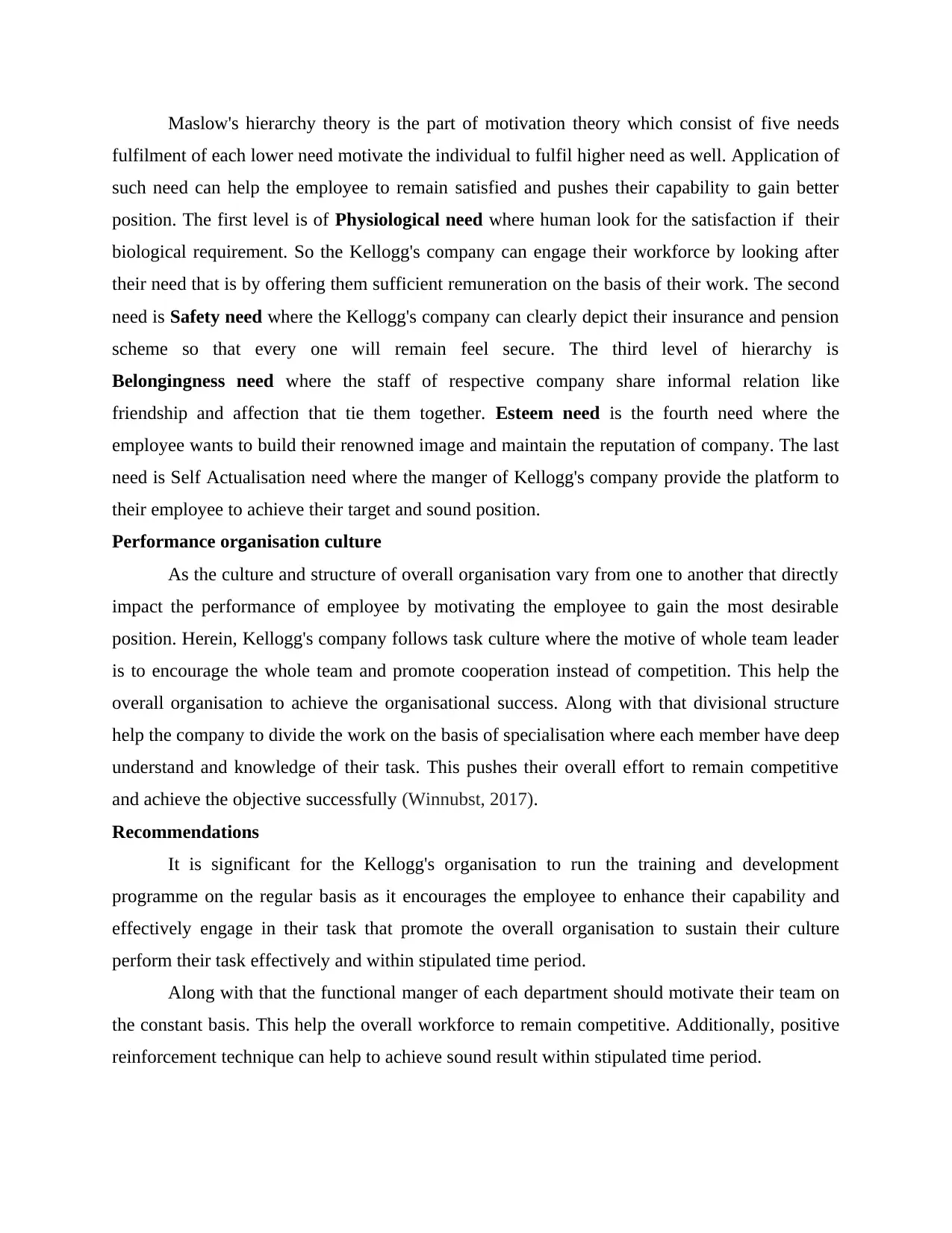
Maslow's hierarchy theory is the part of motivation theory which consist of five needs
fulfilment of each lower need motivate the individual to fulfil higher need as well. Application of
such need can help the employee to remain satisfied and pushes their capability to gain better
position. The first level is of Physiological need where human look for the satisfaction if their
biological requirement. So the Kellogg's company can engage their workforce by looking after
their need that is by offering them sufficient remuneration on the basis of their work. The second
need is Safety need where the Kellogg's company can clearly depict their insurance and pension
scheme so that every one will remain feel secure. The third level of hierarchy is
Belongingness need where the staff of respective company share informal relation like
friendship and affection that tie them together. Esteem need is the fourth need where the
employee wants to build their renowned image and maintain the reputation of company. The last
need is Self Actualisation need where the manger of Kellogg's company provide the platform to
their employee to achieve their target and sound position.
Performance organisation culture
As the culture and structure of overall organisation vary from one to another that directly
impact the performance of employee by motivating the employee to gain the most desirable
position. Herein, Kellogg's company follows task culture where the motive of whole team leader
is to encourage the whole team and promote cooperation instead of competition. This help the
overall organisation to achieve the organisational success. Along with that divisional structure
help the company to divide the work on the basis of specialisation where each member have deep
understand and knowledge of their task. This pushes their overall effort to remain competitive
and achieve the objective successfully (Winnubst, 2017).
Recommendations
It is significant for the Kellogg's organisation to run the training and development
programme on the regular basis as it encourages the employee to enhance their capability and
effectively engage in their task that promote the overall organisation to sustain their culture
perform their task effectively and within stipulated time period.
Along with that the functional manger of each department should motivate their team on
the constant basis. This help the overall workforce to remain competitive. Additionally, positive
reinforcement technique can help to achieve sound result within stipulated time period.
fulfilment of each lower need motivate the individual to fulfil higher need as well. Application of
such need can help the employee to remain satisfied and pushes their capability to gain better
position. The first level is of Physiological need where human look for the satisfaction if their
biological requirement. So the Kellogg's company can engage their workforce by looking after
their need that is by offering them sufficient remuneration on the basis of their work. The second
need is Safety need where the Kellogg's company can clearly depict their insurance and pension
scheme so that every one will remain feel secure. The third level of hierarchy is
Belongingness need where the staff of respective company share informal relation like
friendship and affection that tie them together. Esteem need is the fourth need where the
employee wants to build their renowned image and maintain the reputation of company. The last
need is Self Actualisation need where the manger of Kellogg's company provide the platform to
their employee to achieve their target and sound position.
Performance organisation culture
As the culture and structure of overall organisation vary from one to another that directly
impact the performance of employee by motivating the employee to gain the most desirable
position. Herein, Kellogg's company follows task culture where the motive of whole team leader
is to encourage the whole team and promote cooperation instead of competition. This help the
overall organisation to achieve the organisational success. Along with that divisional structure
help the company to divide the work on the basis of specialisation where each member have deep
understand and knowledge of their task. This pushes their overall effort to remain competitive
and achieve the objective successfully (Winnubst, 2017).
Recommendations
It is significant for the Kellogg's organisation to run the training and development
programme on the regular basis as it encourages the employee to enhance their capability and
effectively engage in their task that promote the overall organisation to sustain their culture
perform their task effectively and within stipulated time period.
Along with that the functional manger of each department should motivate their team on
the constant basis. This help the overall workforce to remain competitive. Additionally, positive
reinforcement technique can help to achieve sound result within stipulated time period.
Paraphrase This Document
Need a fresh take? Get an instant paraphrase of this document with our AI Paraphraser
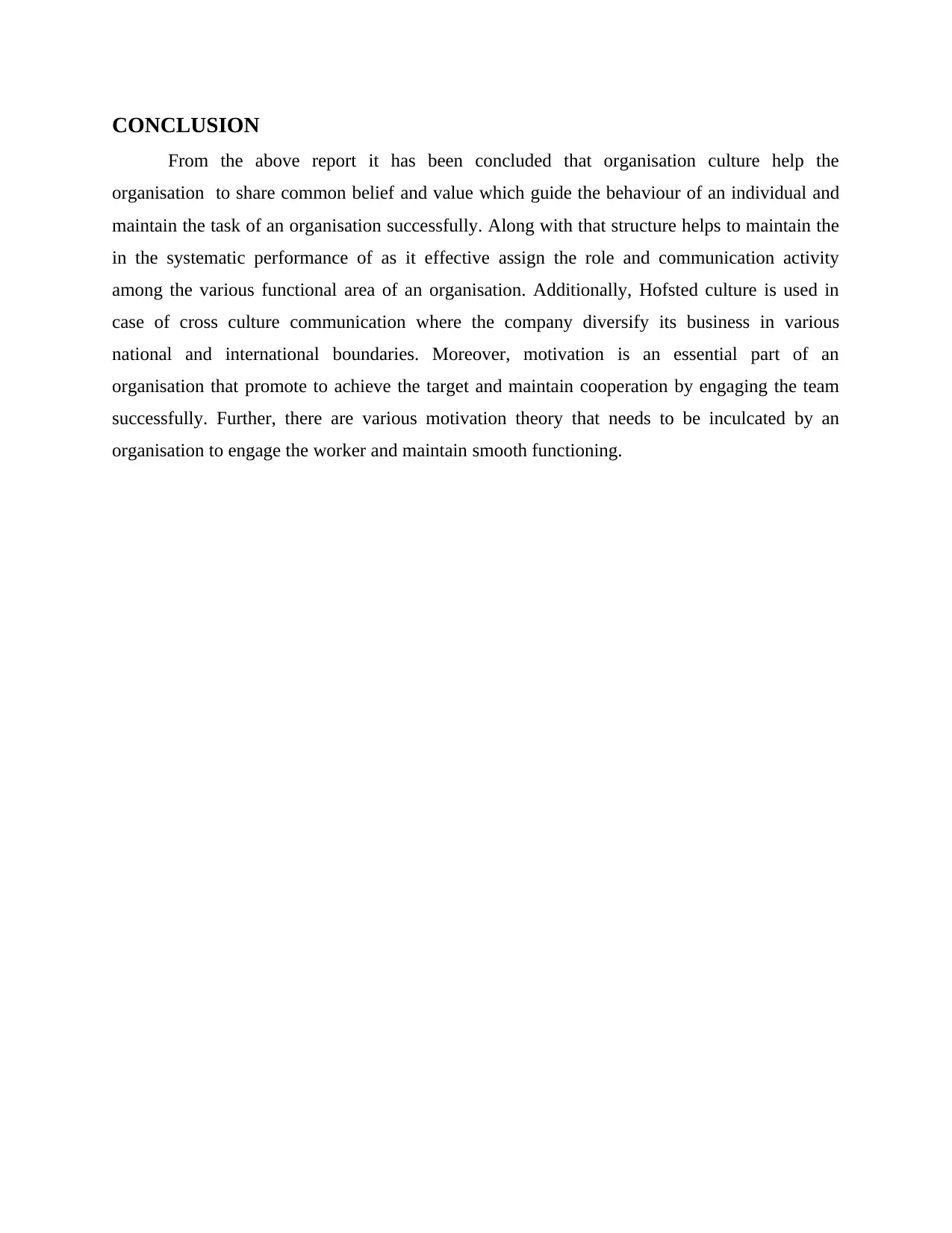
CONCLUSION
From the above report it has been concluded that organisation culture help the
organisation to share common belief and value which guide the behaviour of an individual and
maintain the task of an organisation successfully. Along with that structure helps to maintain the
in the systematic performance of as it effective assign the role and communication activity
among the various functional area of an organisation. Additionally, Hofsted culture is used in
case of cross culture communication where the company diversify its business in various
national and international boundaries. Moreover, motivation is an essential part of an
organisation that promote to achieve the target and maintain cooperation by engaging the team
successfully. Further, there are various motivation theory that needs to be inculcated by an
organisation to engage the worker and maintain smooth functioning.
From the above report it has been concluded that organisation culture help the
organisation to share common belief and value which guide the behaviour of an individual and
maintain the task of an organisation successfully. Along with that structure helps to maintain the
in the systematic performance of as it effective assign the role and communication activity
among the various functional area of an organisation. Additionally, Hofsted culture is used in
case of cross culture communication where the company diversify its business in various
national and international boundaries. Moreover, motivation is an essential part of an
organisation that promote to achieve the target and maintain cooperation by engaging the team
successfully. Further, there are various motivation theory that needs to be inculcated by an
organisation to engage the worker and maintain smooth functioning.
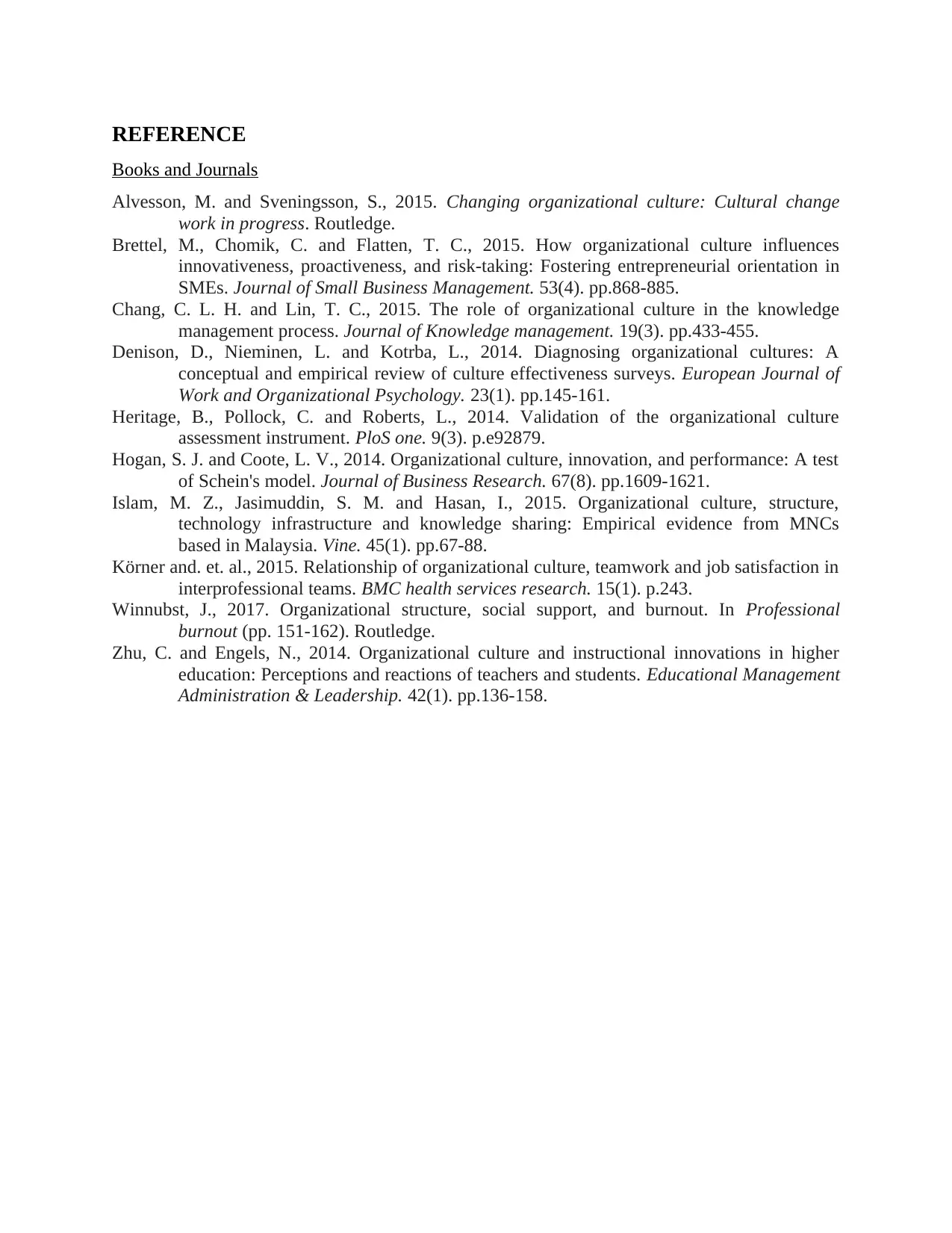
REFERENCE
Books and Journals
Alvesson, M. and Sveningsson, S., 2015. Changing organizational culture: Cultural change
work in progress. Routledge.
Brettel, M., Chomik, C. and Flatten, T. C., 2015. How organizational culture influences
innovativeness, proactiveness, and risk‐taking: Fostering entrepreneurial orientation in
SMEs. Journal of Small Business Management. 53(4). pp.868-885.
Chang, C. L. H. and Lin, T. C., 2015. The role of organizational culture in the knowledge
management process. Journal of Knowledge management. 19(3). pp.433-455.
Denison, D., Nieminen, L. and Kotrba, L., 2014. Diagnosing organizational cultures: A
conceptual and empirical review of culture effectiveness surveys. European Journal of
Work and Organizational Psychology. 23(1). pp.145-161.
Heritage, B., Pollock, C. and Roberts, L., 2014. Validation of the organizational culture
assessment instrument. PloS one. 9(3). p.e92879.
Hogan, S. J. and Coote, L. V., 2014. Organizational culture, innovation, and performance: A test
of Schein's model. Journal of Business Research. 67(8). pp.1609-1621.
Islam, M. Z., Jasimuddin, S. M. and Hasan, I., 2015. Organizational culture, structure,
technology infrastructure and knowledge sharing: Empirical evidence from MNCs
based in Malaysia. Vine. 45(1). pp.67-88.
Körner and. et. al., 2015. Relationship of organizational culture, teamwork and job satisfaction in
interprofessional teams. BMC health services research. 15(1). p.243.
Winnubst, J., 2017. Organizational structure, social support, and burnout. In Professional
burnout (pp. 151-162). Routledge.
Zhu, C. and Engels, N., 2014. Organizational culture and instructional innovations in higher
education: Perceptions and reactions of teachers and students. Educational Management
Administration & Leadership. 42(1). pp.136-158.
Books and Journals
Alvesson, M. and Sveningsson, S., 2015. Changing organizational culture: Cultural change
work in progress. Routledge.
Brettel, M., Chomik, C. and Flatten, T. C., 2015. How organizational culture influences
innovativeness, proactiveness, and risk‐taking: Fostering entrepreneurial orientation in
SMEs. Journal of Small Business Management. 53(4). pp.868-885.
Chang, C. L. H. and Lin, T. C., 2015. The role of organizational culture in the knowledge
management process. Journal of Knowledge management. 19(3). pp.433-455.
Denison, D., Nieminen, L. and Kotrba, L., 2014. Diagnosing organizational cultures: A
conceptual and empirical review of culture effectiveness surveys. European Journal of
Work and Organizational Psychology. 23(1). pp.145-161.
Heritage, B., Pollock, C. and Roberts, L., 2014. Validation of the organizational culture
assessment instrument. PloS one. 9(3). p.e92879.
Hogan, S. J. and Coote, L. V., 2014. Organizational culture, innovation, and performance: A test
of Schein's model. Journal of Business Research. 67(8). pp.1609-1621.
Islam, M. Z., Jasimuddin, S. M. and Hasan, I., 2015. Organizational culture, structure,
technology infrastructure and knowledge sharing: Empirical evidence from MNCs
based in Malaysia. Vine. 45(1). pp.67-88.
Körner and. et. al., 2015. Relationship of organizational culture, teamwork and job satisfaction in
interprofessional teams. BMC health services research. 15(1). p.243.
Winnubst, J., 2017. Organizational structure, social support, and burnout. In Professional
burnout (pp. 151-162). Routledge.
Zhu, C. and Engels, N., 2014. Organizational culture and instructional innovations in higher
education: Perceptions and reactions of teachers and students. Educational Management
Administration & Leadership. 42(1). pp.136-158.
⊘ This is a preview!⊘
Do you want full access?
Subscribe today to unlock all pages.

Trusted by 1+ million students worldwide
1 out of 9
Related Documents
Your All-in-One AI-Powered Toolkit for Academic Success.
+13062052269
info@desklib.com
Available 24*7 on WhatsApp / Email
![[object Object]](/_next/static/media/star-bottom.7253800d.svg)
Unlock your academic potential
Copyright © 2020–2025 A2Z Services. All Rights Reserved. Developed and managed by ZUCOL.




